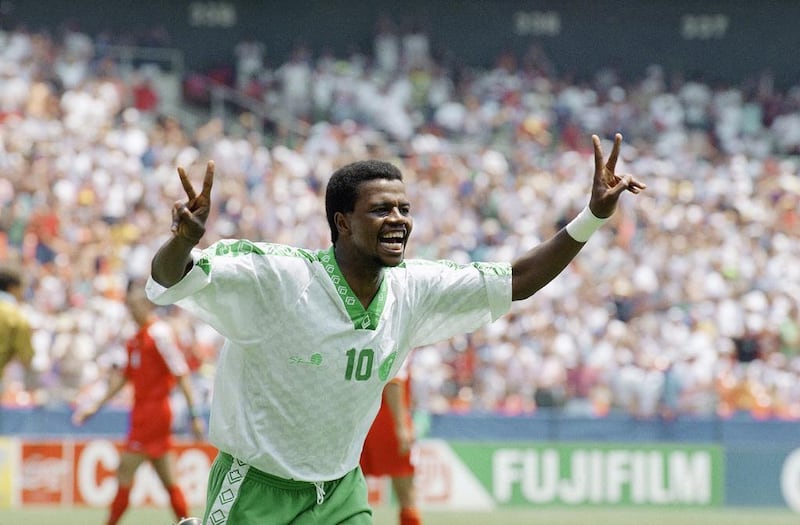Magnificent and surreal as it was, Saeed Al Owairan's goal against Belgium did a little disservice to Saudi Arabia at the 1994 World Cup. Extravagantly gifted and best suited just behind a striker, Al Owairan was always a bit of a showboater.
He once lobbed a keeper from the halfway line. He also never needed an invitation to shoot from distance, and his left foot was usually the first to the scene of any free kick, most often to nudge midfielder Khalid Al Muwallid out of the way.
That goal, finished with his much weaker right foot, turned out to be a double-edged sword, as Al Owairan would later admit. He became sick of watching it repeatedly, and his ensuing celebrity eventually landed him, briefly, in jail.
What it also did was narrow that Saudi team to one image, one goal and one individual burst of brilliance. It was a shame because, 20 years on, that side remains arguably the greatest from the Gulf or wider Arab world; it sits easily among the top Asian sides ever seen.
Al Owairan could be brilliant, but he was not alone. In fact, they were unevenly blessed with attacking players. At least nine in the squad were essentially attack-minded: all happy to shoot from range, all wispily skilful enough to skip past a challenge or two.
Put together, the mix was diverse. They pricked defences with sharp counter-attacks, building on quick and clever short passing and, in particular, the interplay orchestrated upfield by Sami Al Jaber. They could be more direct. Their full-backs attacked. They were a threat at set pieces.
Their goals spoke of this range: Fouad Amin’s long-range opportunistic strike against Morocco; the quick diagonal ball that earned Al Jaber a penalty in the same game; Amin’s header from a free kick against the Netherlands.
And if Al Owairan’s goal was special, Fahd Al Ghesheyan languidly turning past a defender and firing home from a narrow angle against Sweden spoke of an equal gift.
It could have been even more delicious, if only Majed Abdullah had been younger. Saudi Arabia’s greatest striker, a continental giant, was 34 and at the end of a long, glittering but injury-marred career. He was taken along and captained the squad, as much out of respect as form, and played only a couple of halves.
Khalid Al Romaihi, tragically, was not there at all. He had died the previous year in a car crash, on the cusp of a giddy rise. Al Romaihi had been the star forward in the momentous Saudi triumph at the U16 World Cup in 1989, the wider, elder world awaiting his talent.
But if they lived by their attack, they died by their defence. At the continental level, by making six of seven Asian Cup finals from 1984 to 2007, and winning three of them, Saudi Arabia had built a formidable defensive reputation. In 17 tournament games between 1984 and 1992, they conceded only seven goals.
The problem was that, by 1994, the chief orchestrator and muscle at the back, the imperial Saleh Al Naima, had retired. Now their defence looked physically and tactically light. In goal, Mohammad Al Deayea was a Saudi legend but a costly quirk at international level, still carrying telltale signs of an early career spent in handball.
Ultimately, it hardly mattered because in becoming only the second Asian side to qualify for the second round, their place in history was assured. Other than Morocco in 1986, they remain the only country from the larger Arab world to have gone that far. Algeria may join them if they win today.
Though they qualified for every World Cup thereafter until 2006, the sheen went quickly. Results since speak of a greater decay than just the dissipation of a generation. In truth, it had not ever been about just a golden generation, though the youth batch of 1989 was particularly fruitful.
Saudi Arabia had been rising for some time and bestrode Asian football not just for five or 10 years, but from the early 1980s up to the mid-2000s.
It was an age. Good players emerged throughout that period, and it did not matter that they tore through coaches – they had four in the year running up to the World Cup.
The fall is a familiar tale, of not building on their achievements of 1994, not sticking to their own decisions, not allowing their own players enough foreign exposure while happily stuffing their league with foreign talent.
If that goal turned Al Owairan’s fortunes upside down, then it did not do any different for those of Saudi Arabia.
osamiuddin@thenational.ae
Follow us on Twitter at @SprtNationalUAE





